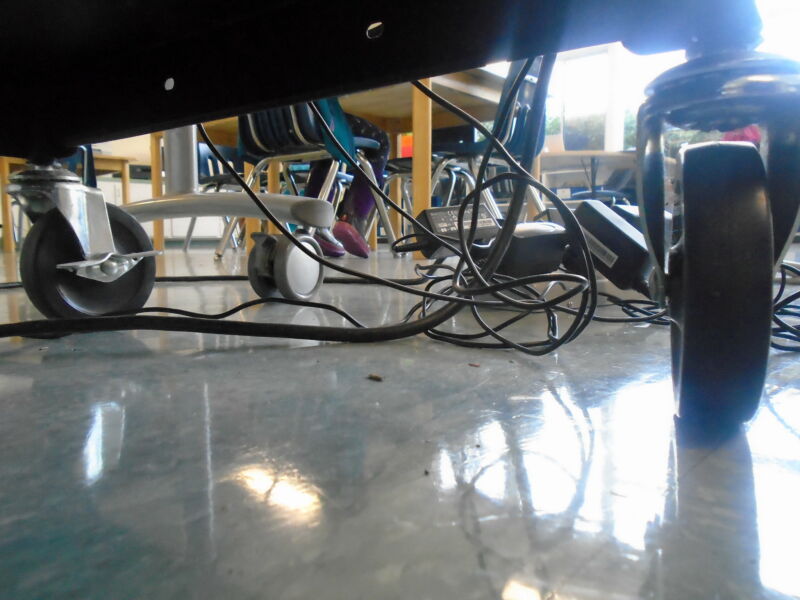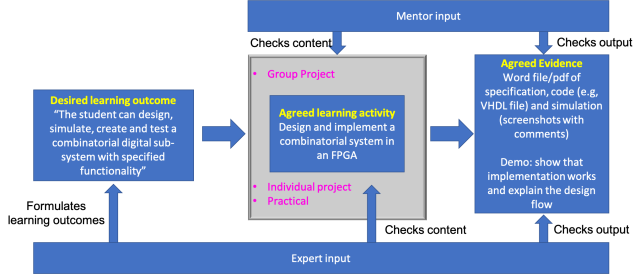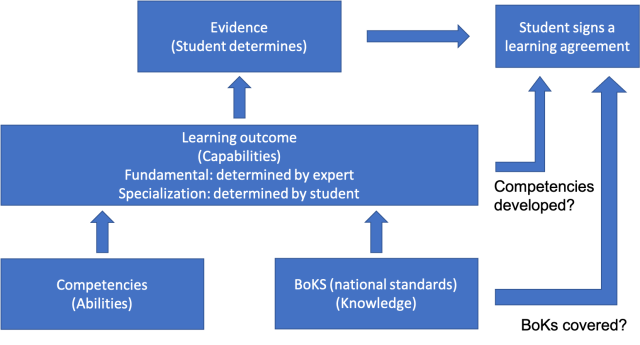
Early in 2020, I wrote about my experiences of moving to online learning: learning to use new tools, changing the way I taught, and dealing with the challenges of remote assessment. Sitting, unmentioned in the background, was the fact that the faculty where I teach had already agreed to revamp our electrical engineering curriculum, which directs the lives of students during three of their four years here. This raised a rather critical question: do we stick with the old in these trying times, or forge ahead with something new? In the end, we decided that we would press on with the new.
Then, just to add to the confusion, management decided that we should have two student intakes: one in August/September (the traditional starting time for new students), and one in February. This meant that, if we were fast enough, we could trial the new curriculum on a small group of students that started in February, rather than jumping in the deep end in September. After a lot of work, and with much material still to be developed, we think we are ready to roll.
One of the best parts of developing the new curriculum has been the criticism and feedback we’ve had from colleagues, students, and alumni. Now, with a month to go before we'll be using the new curriculum, I want to open it up to critique by you, the Ars readers. I’m ready to be the Christmas roast.
Out with the old
Our old curriculum is very traditional. We slog through courses of traditional lectures, backed up by practical exercises that, hopefully, link the theory to practice. The students do project work throughout their degree. These projects are a bit like an overgrown vestigial organ: they take a lot of work, but, as far as the students are concerned, don’t have a lot of functionality.
Our assessment is also very traditional. Almost every subject has a written exam. The final grade is entirely determined by the exam, as long as the student has also obtained a passing grade on their practical exercises.
We consistently score low in student satisfaction, and we have a higher than average drop-out rate in first year. Students often fail to see the relevance of what is taught. Furthermore, our students often fail to perceive the links between the different subjects. While the students aren't overjoyed, employers that take our graduates are happy, observing that they seem to have the right skill set.
The question for us: how can we improve our delivery, so that we reduce the weaknesses, but still graduate students that have the right skill set?
In with the new
We decided that we would drag our curriculum out of the 19th century and squarely into the 20th (education is conservative, so baby steps). The first change was to scrap all the courses. We no longer offer “analog electronics” or anything along those lines. These have been replaced with a set of “learning outcomes.” A learning outcome is a statement about what a student can do. In order to get their study credits, a student has to demonstrate to our satisfaction that they can do.
To take a specific example, one of our learning outcomes reads “You can design, simulate, create and characterize a DC network of passive components with a specified response.” That is a rather vague statement, but it is backed up by a series of more detailed statements that tell the student exactly what we expect to see. For instance, the student should demonstrate that they can simulate a DC circuit, that they can perform accurate measurements on the circuit, that they can hand-calculate the voltages and currents at any node in the circuit, and more.
How the student does that is, to a large degree, up to them: they simply have to deliver evidence of their mastery of a learning outcome. To help the students, we provide them with group projects that are defined only in terms of a theme (e.g., healthcare). The student group gets to determine the details of the project. The students take on the portion of the project that's linked to their learning outcomes. In other words, a student that wants to pursue analog electronics can work on whatever analog electronics are needed to complete the healthcare project. They will use their contribution to the project as evidence of an analog electronics learning outcome. The process is illustrated below.

Maintaining standards, preserving freedom
This gives students a lot of freedom, but that has to be balanced against educational requirements. We have to be sure that the students reach a minimum standard. To ensure that we do this, the students have to describe what they are going to do in their project, and this description has to be signed off by their project mentor and a subject-matter expert. So, if a student wants to obtain their analog electronics learning outcome, they have to propose something that meets the standard set by an analog electronics expert. This is all compiled into a (digital) learning agreement that is signed by all parties.
One challenge is that students who are obsessed with one aspect of electrical engineering may neglect other areas. The result would be one-dimensional students who are entirely ignorant of some of the basics in other areas. To avoid this, we have designated certain learning outcomes as mandatory and every student has to achieve those. In that way, we cover the fundamentals of electrical engineering.
Even with the mandatory component, however, we still have nearly half the credits available for electives. Elective learning outcomes are blank. The students are expected to write their own learning outcome, along with describing the evidence that will demonstrate their mastery of the learning outcome. That means that students can take traditional courses at other institutes, or even use their work at a company as part of their education.
The boundary condition is that we (the teachers) have to agree. The student’s learning outcome has to be approved by their mentor and a subject-matter expert. The approval process ensures that the student still has sufficient breadth of knowledge when they graduate. The whole process is illustrated below.

This gives the students the chance to engage with areas that really interest them, hopefully increasing their satisfaction. It also encourages them to consider their education in terms of life after university. They need to justify their choices to themselves and their mentors.
Bootstrapping the first year
One of the big issues with the new curriculum is that first-year students have to learn how to make a learning agreement and most of them will not have sufficient knowledge or experience to do so. To bootstrap the process, the first-year projects come with a theme and a structure that helps the students write their learning agreement.
In the first-year projects, all students have to design and build an analog sensor. The sensor has to be read by a microcontroller that they have programmed, and the sensor data should be used to actuate something. This is still very broad, but gives the students a framework. In the first week, the students have to research the thematic aspect of the project with the aim of learning what physical parameters can be measured and how to do so. Then, based on that knowledge, each student can choose a sensor type and get to work.
In the first year, each student builds every aspect of a project. So, a group of six students builds six different sensors, writes six software implementations, and actuates six different controllers. Then these get combined into one giant system. Where there is overlap (e.g., two students make a temperature sensor), then the group has to make a choice, and justify that choice based on sensor performance or application specifications.
No more uncertainty
One of the things I hate about the current curriculum is that a student can do okay in the practical exercises, hit the exam, bomb that, and then is left floating, trying to somehow manage to pass later (via redoing exams or waiting for when the course is offered again). We really wanted to remove that arbitrary pass/fail moment from the curriculum.
The new curriculum replaces the moment of failure with an invitation to continue. Let’s say that I have come to the end of a project, and I have not managed to produce all the required evidence for a learning outcome. If that happens, my mentor and I can carry that learning outcome forward into the next project. I can keep the evidence that I have already accumulated and add new evidence to it until the learning outcome is achieved.
The key aspect is that I know this is coming. In weekly meetings with my mentor, I will get feedback on what I have done and feed-forward on what I still need to do, so the need to continue won't be a surprise. It also removes the surprise of unexpected results. The evidence is also subject to feedback, and won’t be formally assessed until the mentor and subject matter expert say that it is ready. In other words: I can be delayed in achieving a learning outcome, but I am not going to fail to achieve it. Because the feedback and evidence is all saved, the teachers have a much better picture of my strengths and weaknesses than they had in the old curriculum.
The best part is that, even if I am delayed in achieving a learning outcome, I will still be fully supported, because the evidence is part of a project. The projects are supported by tutors and subject matter experts.
But when do the students go to class?
Wait, I hear you cry. If students are busy with their projects, how will they learn the stuff that goes in the project? We still offer classes, but these are explicitly in support of the learning outcomes and not an end in and of themselves. There are no grades associated with assignments, quizzes, tests or practical exercises. These are explicitly for the students to judge their own progress.
We explicitly give the student the freedom to learn in the manner that best suits them. A student can go to a practical class to learn how to solder if they want to, or they can choose to miss that class. It doesn’t matter. What matters is that, if they have a learning outcome that requires evidence of their ability to solder, they demonstrate that they can solder. How they learn the skill is not important anymore.
A consequence of this is that we will spend more time with the students in their project groups and less time in front of the class. The students will be expected to do more independent learning and, to support this, we will provide more material for independent learning. Basically, we’ve taken to heart the truism that lectures don’t work. So, we shorten up and focus classes only on critical topics, while making the bulk of the material available online in various forms.
Student planning
This approach also requires that the students are self-starting and well-prepared. For some students, this will be a continuation of what they experienced in their last years of high school. However, for many, their newfound independence will come as a shock. To support the students, the mentor will (in the first year) provide weekly support for planning and preparation. But, even here, the students are expected to do the bulk of the work.
The students will be provided with a global plan for when various topics will be covered in lecture classes and the possibility to practice different skills in practical classes. Assignments that explicitly link theory and practical skills will be available. The students will be expected to use this information, along with their project work, to make a plan for the week. The mentors will meet with their students to review their plans on Monday morning. The plan is also expected to include making appointments to see individual teachers where required.
The mentors will take this information into the Friday afternoon teacher meeting. If students are struggling with a specific topic, this will show up in the Monday morning meeting, and can be addressed in the Friday teacher meeting. This means that the teachers can be much more responsive to the students in terms of lesson content.
Rope enough to hang myself
In developing the new curriculum, the management has given us a lot of freedom. We have, for the Netherlands, taken a very radical road. And, yes, I know that there will be bumps in the road along the way. Teachers will have to learn to teach in the new structure. Teachers will have to learn how to make learning agreements. Teachers will have to learn to give up a lot of control to the students. They're undoubtedly going to get each of these wrong a few times while they adjust.
But maybe you can help us identify some potential stumbling points in advance. Given the large changes, I value all forms of feedback, so, fire away in the comments.
"want" - Google News
December 29, 2020 at 06:15PM
https://ift.tt/34S2Ijq
All I want for Christmas is an awesome new curriculum - Ars Technica
"want" - Google News
https://ift.tt/31yeVa2
https://ift.tt/2YsHiXz
Bagikan Berita Ini















0 Response to "All I want for Christmas is an awesome new curriculum - Ars Technica"
Post a Comment